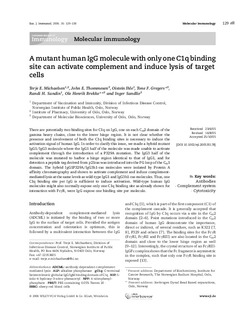| dc.contributor.author | Michaelsen, Terje Einar | |
| dc.contributor.author | Thommesen, John E. | |
| dc.contributor.author | Ihle, Øistein | |
| dc.contributor.author | Gregers, Tone F. | |
| dc.contributor.author | Sandin, Randi Helene | |
| dc.contributor.author | Brekke, Ole Henrik | |
| dc.contributor.author | Sandlie, Inger | |
| dc.date.accessioned | 2018-08-07T10:56:39Z | |
| dc.date.available | 2018-08-07T10:56:39Z | |
| dc.date.created | 2006-10-03T16:28:20Z | |
| dc.date.issued | 2006 | |
| dc.identifier.citation | European Journal of Immunology. 2006, 36 (1), 129-138. | |
| dc.identifier.issn | 0014-2980 | |
| dc.identifier.uri | http://hdl.handle.net/11250/2507797 | |
| dc.description.abstract | There are potentially two binding sites for C1q on IgG, one on each C(H)2 domain of the gamma heavy chains, close to the lower hinge region. It is not clear whether the presence and involvement of both the C1q binding sites is necessary to induce the activation signal of human IgG. In order to clarify this issue, we made a hybrid mutant IgG1/IgG3 molecule where the IgG1 half of the molecule was made unable to activate complement through the introduction of a P329A mutation. The IgG3 half of the molecule was mutated to harbor a hinge region identical to that of IgG1, and for detection a peptide tag derived from p21ras was introduced into the FG loop of the C(H)1 domain. The hybrid IgG1P329A/IgG3h1-ras molecules were isolated by Protein A affinity chromatography and shown to activate complement and induce complement-mediated lysis at the same levels as wild-type IgG1 and IgG3h1-ras molecules. Thus, one C1q binding site per IgG is sufficient to induce activation. Wild-type human IgG molecules might also normally expose only one C1q binding site as already shown for interaction with FcgammaR, were IgG expose one binding site per molecule. | |
| dc.language.iso | eng | |
| dc.relation.uri | http://www3.interscience.wiley.com/cgi-bin/fulltext/112166040/PDFSTART | |
| dc.title | A mutant human IgG molecule with only one C1q binding site can activate complement and induce lysis of target cells | |
| dc.type | Peer reviewed | |
| dc.type | Journal article | |
| dc.source.pagenumber | 129-138 | |
| dc.source.volume | 36 | |
| dc.source.journal | European Journal of Immunology | |
| dc.source.issue | 1 | |
| dc.identifier.doi | 10.1002/eji.200535178 | |
| dc.identifier.cristin | 378948 | |
| cristin.unitcode | 7502,0,0,0 | |
| cristin.unitname | Folkehelseinstituttet | |
| cristin.ispublished | true | |
| cristin.fulltext | original | |
| cristin.qualitycode | 2 | |
